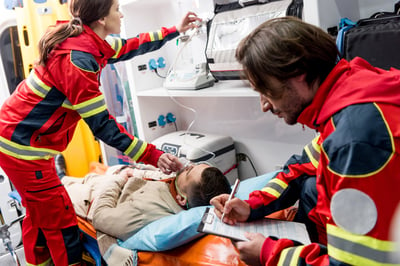4 Must-have Data Points for Dispatch-Billing Alignment and Maximum Reimbursement
Improve ET3 Outcomes with Information Best Practices and Data Exchange
Was this information valuable?

(7 min read) Seek better outcomes for emergency triage, treatment, and transport initiatives by focusing on data and interoperability.
Emergency triage, treatment, and transport...it’s what we EMS pros do. Yet, only one of these components has traditionally led to payment for EMS agencies (which is often our desired outcome).
While HCPCS billing codes like A0998 have helped to change this dynamic, that alone doesn’t make enough of a difference to keep many of our EMS ships afloat. This is partly why the ET3 pilot is constructed the way it is: to develop a system whereby our fee-for-service model applies even when service doesn’t result in transport to a hospital. ET3 outcomes, nonetheless, are measured by accounting for the big picture of prehospital care and system-approached patient care, rather than on individual snapshots of what agencies need in order to operate call-by-call.

Information and interoperability between healthcare partners—and their software—can reshape how we have traditionally looked at outcomes related to triage, treatment, and transport. Let’s break each of these three “T” components down and talk about how we can make—and document—a positive difference.
Triage
Your up-front assessment of patients who may benefit from alternative treatment pathways, system re-navigation, or even transport diversion is often focused around those patients who are experiencing diabetic complaints, chronic falls, acute-on-chronic hypertension, pulmonary edema from congestive heart failure, or mental/behavioral illness exacerbation. These patients form the basis of any community paramedicine (CP) or mobile integrated healthcare (MIH) program. Now, that’s not to say that your ET3 journey has to follow traditional CP/MIH program pathways. It does, however, make some sense to initiate a similar approach in terms of patient population identification and information tracking. Questions that agency leadership and ET3 project managers should ask themselves include:
-
What else – or who else – out there can benefit from the triage aspect of the ET3 initiative?
-
What data can you collect that shows either an intended or unintended benefit from implementing process changes like telehealth & remote medical device monitoring?
-
What outreach options do we have in order to promote awareness to different patient populations?
-
Where else can you show a positive outcome as a result of patient population identification and appropriate navigation?
Capturing and analyzing outcomes over time through historical and comparative data for new patient populations is an exciting part of this initiative. After all, we don’t know what we don’t know!
Treatment
Here’s a typical situation: you arrive on scene to find your diabetic patient experiencing a hypoglycemic event. Your crew provides appropriate treatment to their patient and are now at a crossroads in determining whether or not the patient needs transportation to a healthcare facility for additional treatment. Ambulance crews face some version of this scenario on a regular basis. You’ve already identified this patient (triage) as fitting criteria for alternative or diverted transport opportunities, but have you sufficiently planned for the second T in ET3—treatment? The question here isn’t necessarily what more can we do to manage chronic diabetic patients; it’s what aren’t we doing to educate them and to help prevent them from needing treatment in the first place?

Interoperability with other providers in our community plays a role in this case. Communication between EMS and the patient’s primary care physician helps to keep them aware of chronic calls for service and provides timely updates regarding the patient’s at-home status. Medication reconciliation with the pharmacist creates a single source of truth for spotting potential errors, like prescriptions requested by multiple sources. Performing a needs evaluation with a social worker and evaluating dietary requirements with a dietitian can open avenues for alternative patient care that extend beyond the walls of an emergency department. Capturing and sharing all these data points at every point of care helps EMS and other healthcare providers deliver higher quality care in the most appropriate—and cost-effective—setting.
Implementing a data sharing approach like this will allow your agency to track and analyze your need for both individual and community/population treatment over time. Monitoring trends in decreased patient population transports (as a result of on-scene treatment) helps to justify cost diversions to insurance payors, just as it justifies re-admission risks to hospital systems. A trend toward decreased population-centered calls over time may indicate a system-wide improvement in patient outcomes, resulting from more appropriate initial treatment in the beginning. If we find that we emergently treat these patients less often in the future, it would be fair to say that that is a positive outcome!
Transport
How many patients with (you name it) chief complaint are transported to a hospital versus how many are released on scene? Any EMS agency can answer that question easily, but what’s really the benefit? Information (data) management is ever-growing in both popularity and importance within the EMS industry. Gathering and having the information is just one part of the equation; we also need to focus sharing it and analyzing it to improve quality and efficiency.
Of the patients with “x” chief complaint that are transported, how many are discharged from the emergency department (ED), versus how many are admitted to the acute or intensive care units on the floor? Or even a little more complex in nature, how many (or what percentage of) patients that were released were seen in the ED with the same complaint within 24 hours?
Collecting and interpreting this information requires a two-party approach; it requires interoperability in order to truly convert it into outcome-based insight. Once you’ve got this information, you’re able to use data to justify protocol changes, address training needs, or even show community stakeholders the financial benefit of the service that your agency provides (rather than simply the revenue it generates through transport volumes). Excessive ICU admissions might equate to a need for more aggressive protocols or training needs, while an increase in ED discharges may help to justify the need for either basic life support transport options, or even community paramedic follow-up visits.

Let’s say that your crew was on scene with a patient experiencing pulmonary edema suspected to be due to congestive heart failure. They initiated CPAP therapy and transported the patient to the hospital. Your information gathering and documentation shouldn’t stop there.
The hospital can share information like whether this patient was admitted from the ED or whether they showed improvement and were eventually discharged. Was this patient intubated within one hour? Four hours? After arriving at the ED? Did your crew properly triage the patient at the outset, and did their treatment have a positive impact on the patient’s journey throughout the healthcare system?
Outcomes based on yes/no transport status are hardly outcomes. They’re simply output from a drop-down menu on your patient care reporting software. Outcomes are problem-and-solution-based. They encompass the bigger picture beyond what a yes/no field can provide. Outcome data requires analysis, follow-up, and follow-through. In order to show outcomes, you’ve got to capture the information necessary to track, trend, and share with other partners and stakeholders.
If your EMS agency is looking to make a positive impact through its enrollment in the ET3 initiative, focusing your efforts on accurate, complete information, as well as interoperability will likely lead you down the path toward improved triage, treatment, and transport outcomes—both for your agency and for your patients.
Information to Share with Healthcare Partners (and to Ask for in Return)
-
Transport volumes per facility and per patient chief complaint
-
(Patient disposition volumes with admission rates/percentages)
-
-
Patient volumes meeting alert criteria (i.e., sepsis alert, stroke alert)
-
(Alert patients with confirmed diagnosis)
-
-
Full PCRs with completed narratives
-
(Patient follow-ups with diagnosis & disposition)
-
Tips to Improve ET3 Outcomes:
-
Assign a project manager to steer the direction of your ET3 program.
-
Communicate regularly with local partners and stakeholders to ensure information sharing.
-
Monitor your data to identify trends and the potential need for additional data fields and tracking.
-
Look for “more” within your patient populations: keep an open perspective regarding which types of patients can benefit from your community paramedicine program.
-
Don’t focus solely on yes/no results; look for problem-and-solution-based outcomes.
-
Communicate with other ET3 program enrollees to seek alternative ideas and new methods to introduce into your own program.
Related Posts
How EMS Agencies Can Reframe Need and Refocus Resources With Geospatial Analytics
How To Minimize Radio Chatter and Reduce Guesswork With Smarter Dispatch Resource Management
ZOLL Pulse Blog
Subscribe to our blog and receive quality content that makes your job as an EMS & fire, hospital, or AR professional easier.
ZOLL Pulse Blog
Subscribe to our blog and receive quality content that makes your job as an EMS, fire, hospital, or AR professional easier.




